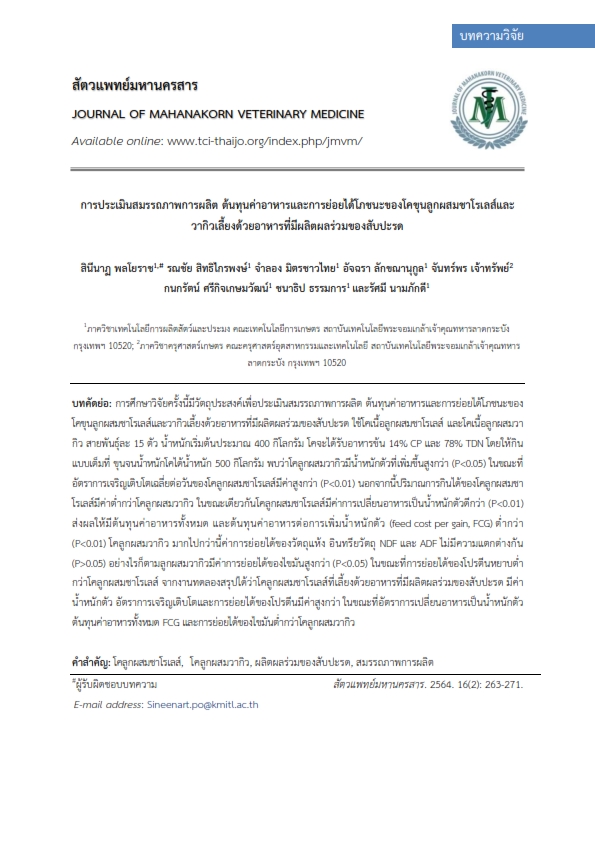Evaluation of Production Performance, Feed Cost and Nutritional Digestibility of Charolais Crossbred and Wagyu Crossbred Beef Cattle Raised by Pineapple Co-products Diet
Main Article Content
Abstract
The current study Evaluation of production performance, feed cost and nutritional digestibility of Charolais crossbred and Wagyu crossbred beef cattle raised by pineapple co-products diet. The study Charolais and Wagyu crossbred, where 15 for each crossbred were used. Initial body weight of experimental beef steers was approximately 400 kg. All experimental beef steers were fed ad libitum, concentrate diet containing 14% CP and 78% TDN with roughage diet as silage made from pineapple by-products from the pineapple processing factory. The experiment lasted until the experimental beef steers had a body weight of approximately 500 kg. The results showed that body weight gain of Wagyu crossbred steer was slightly higher (P<0.05) than that Charolais crossbred steer, whereas Charolais crossbred steer was significantly higher (P<0.01) growth rate than Wagyu crossbred steer. When total feed intake was considered, Charolais crossbred steer was lower (P<0.01) than Wagyu crossbred steer. However, total feed intake of dry matter (DM) and organic matter (OM) were no difference (P>0.05) between both experimental groups. In the meantime, Charolais crossbred steer was a better efficiency of feed conversion ratio (P<0.01) than Wagyu crossbred steer, resulting in Charolais crossbred steer has lower total feed cost and feed cost per gain (FCG) (P<0.01) than Wagyu crossbred steer. For DM, OM, NDF and ADF digestibility did not significance difference (P>0.05) between both Charolais and Wagyu crossbred beef steers, However, Wagyu crossbred steer was higher fat digestibility (P<0.05) while, lower crude protein digestibility than Charolais crossbred steer.
Article Details

This work is licensed under a Creative Commons Attribution-NonCommercial-NoDerivatives 4.0 International License.
References
Fung, W.Y., K.H. Yuen and M.T. Liong. 2010. Characterization of fibrous residues from agrowastes and the production of nanofibers. J. Agric. Food Chem. 58: 8077-8084.
McGee, M., C.M. Welch, J.B. Hall, PAS, W. Small, and R.A. Hill. 2013. E-valuation of Wagyu for residual feed intake: Optimizing feed efficiency, growth, and marbling in Wagyu cattle. Prof. Anim. Sci. 29:51–56.
Schnider, B.H. and W.P. Flat. 1975.The evaluation of feeds through digestibility experiments. Athens: The University of Georgia Press. 423p.
Tumwasorn, S. 2007. Effect of amount of concentrate on profit margin in fattening beef cattle to avoid poverty under Thai village conditions. In Proceedings of the animals science research. The 45th annual conference (pp. 80–86). Bangkok, Thailand: Kasetsart University.
Tumwasorn, S. 2007. Effect of amount of concentrate on profit margin in fattening beef cattle to avoid poverty under Thai village conditions. In Proceedings of the animals science research. The 45th annual conference (pp. 80–86). Bangkok, Thailand: Kasetsart University.
Ueda, Y., A. Watanabe, M. Higuchi, H. Shingu, S. Kushibiki, and M. Shinoda. 2007. Effects of intramuscular fat deposition on the beef traits of Japanese Black steers (Wagyu). Anim. Sci. J. 78:189–194.
van Keulen, J.V. and B.A. Young. 1977. Evaluation of acid insoluble ash as a natural marker in ruminant digestibility studies. J. Anim Sci. 44: 282.
Zhuang, Y.L., Y.F. Zhang and L.P. Sun. 2012. Characteristics of fibre-richpowder and antioxidant activity of pitaya (Hylocereus undatus) peels. Inter. J. Food Sci. Technol. 47:1279–1285.


